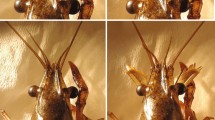Summary
A crayfish (Pacifastacus leniusculus) thoracic pereiopod promotor motor neurone (PMM) receives direct input from the ipsilateral medial giant fibre (MG) via a 1∶1 rectifying electrical synapse. The evidence for this is as follows. (1) PMM spikes follow MG spikes at very short latency. (2) Negative current injected into the PMM propagates antidromically to the MG. (3) Positive voltage perturbations in the PMM (antidromic spikes) fail to propagate to the MG. (4) There is very close anatomical apposition between the PMM and MG as observed in wholemount preparations following staining with Lucifer Yellow. (5) Dye coupling between the MG and a neurone with anatomy similar to the PMM has been observed in very young crayfish, although not in adults.
The electrical input from MG to PMM can be gated by depolarizing IPSPs impinging on the latter. The PMM produces EJPs in the leg promotor muscle which show initial massive antifacilitation, followed by slow facilitation. Homologous neurones occur in each of the 5 thoracic ganglia innervating the legs and claws.
Similar content being viewed by others
Abbreviations
- AC :
-
anterior connective
- EJP :
-
excitatory junctional potential
- GF :
-
giant fibre
- IPSP :
-
inhibitory post-synaptic potential
- LG :
-
lateral giant fibre
- MG :
-
medial giant fibre
- MoG :
-
motor giant neurone
- PC :
-
posterior connective
- PMM :
-
promotor motor neurone
- SG :
-
segmental giant neurone
References
Cattaert D, Clarac F, Neil DM (1988) Anatomical and physiological organisation of the swimmeret system of the spiny lobster Jasus lalandii as adaptive components of the tail flick. J Comp Physiol A 162:187–200
Cooke IRC (1985) Further studies of crayfish escape behaviour. 2. Giant axon-mediated neural activity in the appendages. J Exp Biol 118:367–377
Cooke IRC, Macmillan DL (1985) Further studies of crayfish escape behaviour. I. The role of the appendages and the stereo-typed nature of non-giant escape swimming. J Exp Biol 118:351–365
Giaume C, Korn H (1984) Voltage-dependent dye coupling at a rectifying electrotonic synapse of the crayfish. J Physiol (Lond) 356:151–167
Heitler WJ, Darrig S (1986) The segmental giant neurone of the signal crayfish, and its interactions with abdominal fast flexor and swimmeret motorneurones. J Exp Biol 121:55–75
Heitler WJ, Fraser K (1986) The segmental giant neurone of the hermit crab, Eupagurus bernhardus. J Exp Biol 125:245–269
Kramer AP, Krasne FB, Wine JJ (1981) Interneurons between giant axons and motoneurons in crayfish escape circuitry. J Neurophysiol 45:550–573
Macmillan DL, Cooke IRC, Holmes RM (1985) The neural basis of leg streamlining during crayfish escape behaviour. Proc Austr Physiol Pharmacol Soc 16:164P
Ochi R (1969) Ionic mechanism of the inhibitory postsynaptic potential of crayfish motor giant fiber. Eur J Physiol 311:131–143
Roberts A, Krasne FB, Hagiwara G, Wine JJ, Kramer AP (1982) Segmental giant: evidence for a driver neuron interposed between command and motor neurons in the crayfish escape system. J Neurophysiol 47:761–781
Sillar KT, Skorupski P (1986) Central input to primary afferent neurons in crayfish, Pacifastacus leniusculus is correlated with rhythmic motor output of thoracic ganglia. J Neurophysiol 55:678–688
Wine JJ (1977) Neuronal organisation of crayfish escape behavior: inhibition of giant motoneuron via a disynaptic pathway from other motoneurons. J Neurophysiol 40:1078–1097
Wine JJ (1984) The structural basis of an innate behavioural pattern. J Exp Biol 112:283–319
Author information
Authors and Affiliations
Rights and permissions
About this article
Cite this article
Heitler, W.J., Fraser, K. Thoracic output of crayfish giant fibres. J Comp Physiol A 166, 117–124 (1989). https://doi.org/10.1007/BF00190216
Accepted:
Issue Date:
DOI: https://doi.org/10.1007/BF00190216




